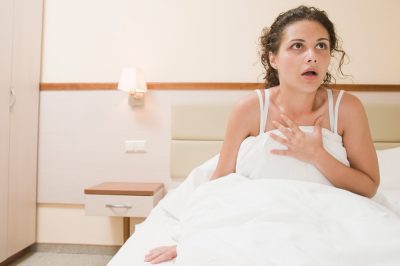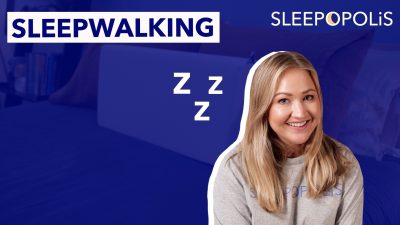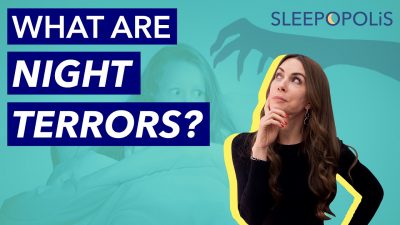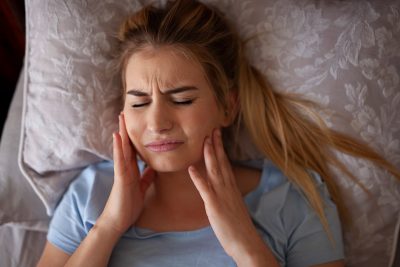The Ultimate Guide to Different Parasomnias
- by Sharon Brandwein
- Updated: September 7, 2023
Table of Contents

In 1998, James Currens walked out of his house and into a nearby pond, where he eventually found himself surrounded by alligators. Using a cane to keep them at bay, Currens shouted for help until a neighbor heard and called 911. Currens escaped the incident with only minor cuts.
In 1987, Kenneth Parks drove 14 miles to his in-law’s house. Parks stabbed his mother-in-law and strangled his father-in-law. After the incident, Parks drove himself to the local police station and confessed.
Both of these stories have one thing in common — the men were under the influence of a common parasomnia we know as sleepwalking when these events occurred.
And while sleepwalking may be one of the more well-known parasomnias, there are many more.
What Is A Parasomnia?
Parasomnias are a collection of sleep disorders, the hallmarks of which are “undesirable physical events or experiences that occur during the initiation of sleep, during sleep or during arousal from sleep.” Parasomnias can result in fatigue and distress. Understandably, they tend to have a deleterious effect on the sleep quality and quantity of both the person experiencing the parasomnia as well as their bed partners.
According to The American Academy of Sleep Medicine, “behaviors related to parasomnias are disconnected from conscious awareness and are devoid of sound judgment.” Some episodes of parasomnia may result in having little to no control over actions.
Different Types Of Parasomnias
According to Dr. Chelsie Rohrscheib, the Lead Sleep Specialist at Wesper, “Parasomnia disorders can further be split into two categories depending on the sleep stage when the disorder typically occurs. [They can] occur during Non-Rapid Eye Movement (NREM) sleep or during Rapid Eye Movement (REM) sleep.”
NREM-Related Parasomnias
The non-rapid eye movement sleep stages include the first stages of our sleep cycle, N1, N2, and N3. NREM parasomnias that occur during these sleep stages are known as disorders of arousal. With NREM parasomnias, the sleeper is usually unaware of the goings-on and typically has no memory of the incident or episode when they wake. Sleepwalking, sleep-related eating disorder, sleep bruxism, and confusional arousals are included in this category.
Sleepwalking
Also known as somnambulism, sleepwalking (as its name implies) is an arousal disorder in which someone gets up and walks around while asleep. Sleepwalking typically occurs during slow-wave sleep (or N3), and physical activity can go beyond simply walking around.
Sleepwalkers have been known to engage in more complex activities like playing a musical instrument, driving, and eating — or, in rare and extreme instances such as the case of Kenneth Parks, murder.
Sleep-Related Eating Disorder
While sleepwalkers have been known to eat while aroused, there’s an entirely separate parasomnia related to eating. Sleep-related eating disorder (SRED) is when someone binge eats involuntarily after a partial awakening from sleep. While those with SRED typically consume high calories foods, some have been known to consume raw meat, pet food, or toxic substances. If it happens frequently, SRED can lead to weight gain, obesity, diabetes, dental cavities, and high cholesterol.
Sleep bruxism
Teeth grinding, or sleep bruxism, is a common parasomnia marked by the clenching, grinding, and gnashing of one’s teeth. Most episodes of teeth-grinding tend to occur in the light stages of non-REM sleep (or N1 and N2). While teeth grinding can leave you feeling tired and unrested, it can also lead to
- Headaches or jaw pain,
- Attrition (or the wearing away of tooth enamel)
- Cracked or chipped teeth
- Unexplained loose teeth
- Tooth pain/sensitivity
Confusional Arousal
Also known as Elpenor syndrome and sometimes referred to as sleep drunkenness, confusional arousals occur when the individual experiences a partial awakening during slow-wave sleep.
During confusional arousal, they are usually confused and “disoriented to time and space.” Bed partners may observe some automatic behaviors like opening their eyes and mumbling that lasts anywhere from a few minutes to a few hours. Like many parasomnias, the individual typically has total amnesia of the event after the fact.
Sleep terrors
As Johns Hopkins All Children’s Hospital notes, sleep terrors are similar to nightmares “but far more dramatic.” Also known as night terrors, sleep terrors are when someone acts out a nightmare. During a sleep terror, the person may jolt up in a terrified or confused state. They’re also likely to scream and thrash about but are unable to othwerwise communicate.
Common signs of night terrors include:
- Racing pulse
- Wide-eyes
- Sleepwalking
- Heavy breathing
- Sweating
REM-Related Parasomnias
REM-related parasomnias typically occur during the latter part of the night, as its name implies, during REM sleep. The most common REM-related parasomnias are REM sleep behavior disorder, nightmares, and sleep paralysis.
REM Sleep Behavior Disorder
RBD (or REM sleep behavior disorder) is another parasomnia, the hallmark of which is dream-enacting behavior. Those with the disorder often experience a loss of the temporary paralysis typical of the REM sleep stage, and it results in them acting out their dreams.
Common signs of REM sleep behavior disorder include:
- Vivid dream engagement
- Increased motor activity, including kicking, punching, yelling, and jumping
- Loud vocalizations such as shouting, screaming, and swearing (often an indicator of unpleasant dreams)
- The person typically wakes up alert and able to recall the dream
Nightmares
Nightmares are dream sequences that seem real — they often result in waking from sleep, and they induce feelings of fear, anxiety, or terror. Physical manifestations of nightmares include sweating, rapid breathing, and pulse racing. In many cases, the dreamer is able to recall some of the details of the nightmare, and there is often little to no confusion or disorientation to note.
Sleep Paralysis
Sleep paralysis occurs when someone cannot move or speak during sleep transitions such as sleep onset or upon arousal. Sleep paralysis episodes can last anywhere from a few seconds to a few minutes, during which time the person is able to move their eyes and breath normally. Episodes of sleep paralysis tend to resolve themself spontaneously, but they also often end once the person is touched or spoken to.
Other Parasomnias
Bedwetting
Most people may not know this, but bedwetting for a person with bladder control is a parasomnia. Also known as sleep enuresis, bedwetting occurs when a person urinates by accident in their sleep. This parasomnia is most often associated with children.
Exploding Head Syndrome (EHS)
Exploding head syndrome is a relatively rare parasomnia that causes someone to awaken from sleep because they perceive a loud noise. The noise isn’t real, but to the individual, it sounds like a loud bang, gunshots, a bomb exploding, or a door slamming. EHS episodes are only momentary, and they’re not dangerous per se, but over the long term, they can lead to fragmented sleep and sleep deprivation.
Sleep-Related Hallucinations
Another type of parasomnia that occurs during transitional sleep stages is sleep-related hallucinations. If these hallucinations occur when someone is falling asleep, they’re known as hypnagogic hallucinations. If they occur upon waking, they’re known as hypnopompic hallucinations. While 86% of all sleep-related hallucinations are visual, these hallucinations can also be auditory, tactile, or kinetic. During a hallucination, the sleeper may feel a presence in the room, which can be pretty frightening.
Symptoms Of Parasomnias
The term parasomnia refers to a group of sleep disorders, and each one comes with its own specific set of symptoms. However, the following symptoms are associated with many of the parasomnias outlined in the previous sections.
- Fragmented sleep
- Confusion upon waking
- Excessive daytime sleepiness and fatigue
- Unexplained injuries
- Movements and vocalizations (observed by bed partners) that you don’t remember
Can Children Experience Parasomnias?
Children can and do experience parasomnias. In fact, they are more common in children than adults. Drilling down even further, we find that NREM parasomnias are more common than REM parasomnias in kids.
Scientists believe that parasomnias are more common in children because the areas of the brain that typically inhibit abnormal sleep behaviors are not yet fully developed. Sleepwalking, nightmares, confusional arousals, and night terrors are the most common parasomnias seen in children, but most kids simply outgrow these behaviors as they get older.
What Causes Parasomnias?
“The cause of parasomnias is not completely understood by science, but most parasomnias are likely the result of dysfunction of certain areas of the brain that are related to sleep and movement,” says Rohrscheib. “We also know that certain mental health disorders like depression, anxiety, and PTSD also increase your risk.” Rohrscheib also notes that drugs and medications that change the neurochemistry of the brain round out the list of possible causes for parasomnias.
Ultimately the causes of parasomnias can be broken down into two categories: issues that disrupt sleep and pre-existing health issues.
Issues That Disrupt Sleep
- Other sleep disorders
- Sleep deprivation or a lack of sleep
- Irregular sleep and wake cycles
- Incomplete transitions between sleep and waking stages
- Certain medications
- Immaturity of the sleep-wake cycle (more often associated with kids)
Pre-Existing Conditions And Other Health Issues
- Alcohol or substance abuse
- Chronic stress
- Genetics
- Neurological diseases/issues (Parkinson’s disease, Lewy body dementia, stroke)
- Head injuries
How Are Parasomnias Diagnosed?
While polysomnograms and EEGs are good diagnostic tools for sleep disorders, Rohrscheib notes that diagnosing parasomnias can be easier than that. More often than not, parasomnias can be diagnosed by obtaining a careful clinical history of the patient — one that assesses the timing and expression of the abnormal behaviors.
“You do not necessarily need a full sleep study to diagnose parasomnias,” she says. “A sleep specialist can usually determine if you have a parasomnia by collecting your sleep history and asking specific screening questions.”
Beyond clinical histories, sleep diaries and partner logs can also be useful tools.
How Are Parasomnias Treated?
“The way a parasomnia is treated is very specific to the type of parasomnia a person has,” says Rohrscheib. “Some parasomnias [may] require medication and therapy, while [some] parasomnias that have the potential to become dangerous, such as sleepwalking, may require special restraints to help keep the person in bed.”
Rohrscheib goes on to tell Sleepopolis that sleep deprivation can increase the frequency of parasomnias, so many people will notice a marked improvement in their parasomnia just by getting more high-quality sleep.
If you or a loved one is dealing with a parasomnia, practicing good sleep hygiene and limiting (or avoiding) alcohol and recreational drugs are excellent first steps toward mitigating its effects on your sleep and daily life.
For more serious cases, you may want to speak with your doctor for next steps, which may include:
- Medications and supplements, the most common of which are benzodiazepines, antidepressants, Clonazepam, and melatonin
- Cognitive behavioral therapy
Protecting Yourself From Parasomnias
“Parasomnias are rarely dangerous,” says Rohrscheib. “But there is a minor risk for a person with a parasomnia like sleepwalking who may hurt themselves or others, but this is usually only in extreme cases.”
If you have a parasomnia that could be dangerous to yourself or others, Rohrscheib suggests taking steps to make your bedroom safe and avoid sleeping with a partner. Those steps include:
- Removing sharp items or weapons from the bedroom
- Securing small furniture items like nightstands and bedside lamps
- Padding the sharp edges of bedside furniture
- Adding alarms to exit points like windows and doors
- Sleeping in separate beds or rooms if aggressive behaviors are part of the parasomnia
The Last Word From Sleepopolis
Parasomnia is an umbrella term for a group of sleep disorders. Parasomnias are typically broken down into NREM-related parasomnias and REM-related parasomnias. From those two categories, sleepwalking, night terrors, sleep bruxism, nightmares, and sleep paralysis are some of the more commonly known parasomnias. Common symptoms of parasomnias include fragmented sleep, excessive daytime sleepiness, movements and vocalizations, and unexplained injuries. In rare cases, parasomnias can be dangerous, but there are steps you can take to protect yourself and your loved ones. For more severe cases, you might consider speaking with your doctor, as medication and therapy may prove more helpful.
Subscribe Today!
Get the latest deals, discounts, reviews, and giveaways!



